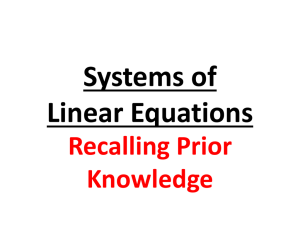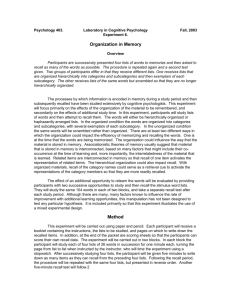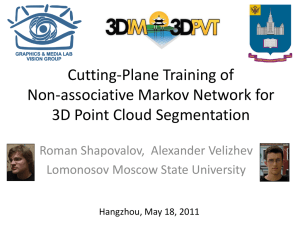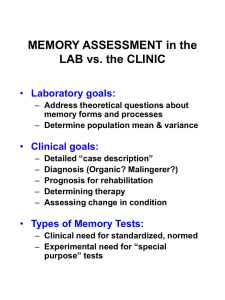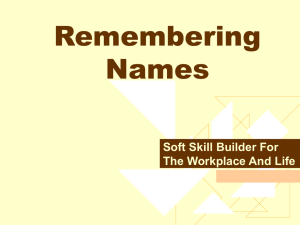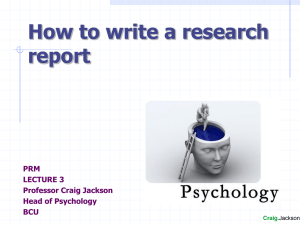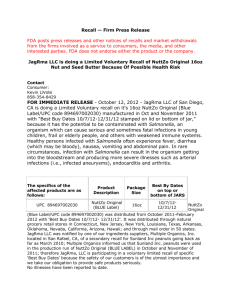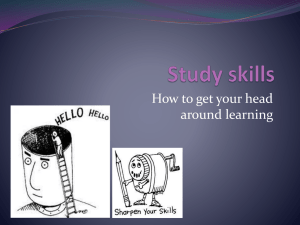Working with Clients with Trauma
advertisement
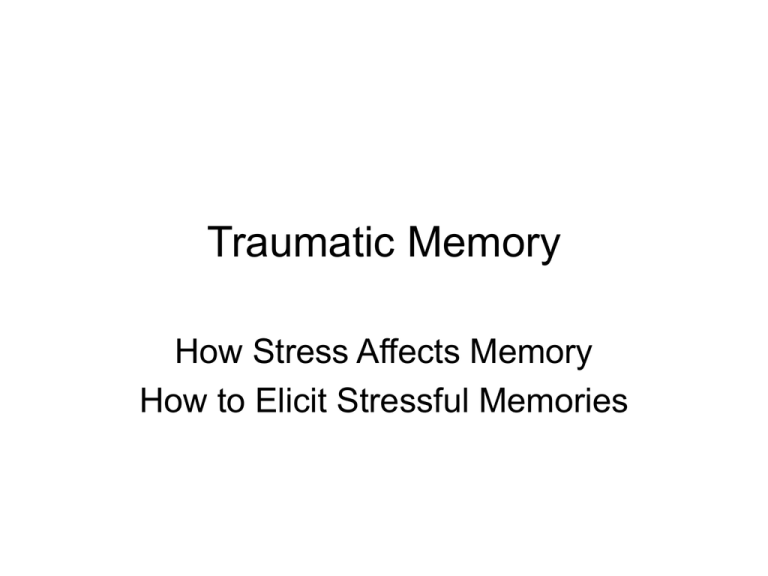
Traumatic Memory How Stress Affects Memory How to Elicit Stressful Memories “In any war story, but especially a true one, it’s difficult to separate what happened from what seemed to happen. What seems to happen becomes its own happening and has to be told that way…” When a booby trap explodes, you close your eyes and duck and float outside of yourself. When a guy dies…you look away and then look back for a moment and then look away again. The pictures get jumbled; you tend to miss a lot. And then afterward, when you go to tell about it, there is always that surreal seemingness, which makes the story seem untrue. But which in fact represents the hard and exact truth as it seemed.” (Tim O’Brien, The Things They Carried) “Absolute occurrence is irrelevant. A thing may happen and be a total lie; another thing may not happen and be truer than the truth.” (Tim O’Brien) “In many cases a true war story cannot be believed. If you believe it, be skeptical. It’s a question of credibility. Often the crazy stuff is true and the normal stuff isn’t because the normal stuff is necessary to make you believe the truly incredible craziness. In other cases, you can’t even tell a true war story. Sometimes it’s just beyond telling.” Tim O’Brien Outline • • • • • Memory: Active Process Reaction to stress Types of memory Effect of stress on memory Techniques to enhance reporting Luanugage Mreomy • Aoccdrnig to a rscheearch at Cmabrigde Uinervtisy, it deosn't mttaer in waht oredr the ltteers in a wrod are, the olny iprmoetnt tihng is taht the frist and lsat ltteer be at the rghit pclae. The rset can be a toatl mses and you can sitll raed it wouthit porbelm. Tihs is bcuseae the huamn mnid deos not raed ervey lteter by istlef, but the wrod as a wlohe. The Puzzle of Memory • First considered an entity (the Engram) • Now considered a network – Neural pathways that link perception with interpretation – Initial plasticity that shrinks in response to exposure – – Neuro-network of culture and language – Individual difference • Memory entails – Stimulation of the network (laying down a memory) – Intra-cerebral network (Interpretation of perception) – Re-trace of new network (Recall) The Complexity of the Network • Number of neurons in cerebral cortex (adult) about 20,000,000,000) • Number of synapses (adult) 2,000-5,000 per neuron) • Glial cells 10,000 for every neuron From MIT Human Information Processing Project (2005) http://vadim.www.media.mit.edu/MAS862/Project.html CREB cyclic amp-response element binding protein Two forms: activator (Velcro) or repressor (Teflon) Kinds of Memory • Eidetic Memory – Detailed recollection (Photographic Memory) – Scene as a whole (“video-recording”) • Conceptual Memory (Frontal Lobe Interpretation) – Meaning of events – Reconstructive to fit concepts – Errors in direction of beliefs (recall consistent with beliefs) • Physiological memory – Sensory recall (olfactory stimulation of memory) – “Hot zone” memory – Déjà vu • False memory (recall of what never occurred; associated with emotion, social desirability) – – – – • Implanted Suggested Hysterical Confabulatory Cultural memory (examples: “Thanksgiving Dinner” “Silent Female” phenomena) – Interpretation according to accepted constructs – Collective vs. individual memory (Village vs. self) – Family vs. individual memory Traumatic Memory • Most research on – Post-traumatic not Intra-traumatic Stress – Disorder not “normal” response • Most research – On men, post Viet Nam – On women, post rape • Post 911 – Internalized response • Suspicion • New perceptions – World View Shift • Safe to threatened • Predictable to “unpredictable” but predictably sinister Response During Stress • • • • • Survival coping/automatic responding Dissociation/ “out-of body”; separation Narrowing of focus all the way to blackout Exaggeration of personality style Lack of reflection; intense but limited attention (the “keyhole” phenomenon) • Cognitive static and overload Memory Characteristics After Trauma • Longer lasting, “packaged” effects: construct vs. detail (Chinese Poet) • Mimic PTSD symptoms (without decrease in function) • Difficult to assess – Nature of memory – what is remembered – “Video-camera in the head” aspect of memory more complicated. (Video present but cannot be parsed out; like “reading” during a dream) – “Memory” result of active, on going process of retrieval and interpretation. (Holocaust memory) Specific Effects of Trauma on Memory • Limit on eidetic recall; although sense that scene is stored (emotional memory) • “Blackouts” that include time and detail gaps • Increased suggestibility but decreased certainty • Identification (Blend of self and others ) • Consolidation (Concentration of relevant events without regard to time) • Integration (Reconstructed memory with added meaning) • The process of using related information and empathy to an event real. • Explaining a sensation (shame, horror, etc). Wisconsin Memory Study • Ordinary class • Stress-induced class – Confederate “Student” chastised for using computer in class – Students asked the following – Confederate “Student” chastised for using computer in class – Students asked the following • Are computers allowed to be used in the class? • Were YOU specifically told not to use your computer? • Are computers allowed to be used in the class? • Were YOU specifically told not to use your computer? Results Showing Identification Low Stress Condition 100 90 80 70 % 60 CR* 50 GradStud PreLaw PreMed Undergrad 40 30 20 10 0 Rule *Confabulated recall Self Results Showing Identification High Stress Condition 100 90 80 % CR 70 60 Grad Prelaw Premed Undergrad 50 40 30 20 10 0 Rule Self Franz, R.T, et al, 2006 Recollections of Traumatic Events Decreased Recall of Detail Making sense of the event Reconstruction Recall Eidetic memory Reconstruction COMMUNICATION Reporting Common Fallacies About Accurate Memory • A video-tape of an event • We recall major stressful events: “the seared image” – True for observers; may not be so for victims (“Snap shot memory.”) – Under threat and stress, memory may decrease • Consistency correlates with probity – Inconsistency in detail common as memory unfolds • “Unpacking the trunk in the attic” – Certain core memories remain as ideas with a decay of the supporting data • True memory is consistent over time – Memory is an active process that gets reprocessed as experiences change – Memories vary with learning, mood, reflection, agenda • Recollection is the recall of what was – Memory is active and the process of retelling serves many purposes Enhancing Precision in a Narrative Account • Context of the telling – Nature of relationship • • • • Trust Time Support/security Treatment Permission (to forget, correct, tell truth) • Order of techniques – – – – – – Cathartic: uninterrupted story-telling Timeline Chaining Clustering Uncovering Review and memory cues Cathartic Story Telling • Develops empathic relationship – You care and want to know and understand • “It’s my interview; not yours.” (Anglican Romanian) • Allows assessment of language facility – Where are the difficulties – How verbal, how difficult to follow • Provides overview of information and a starting point Bio-line • Constructed by attorney • Later check with client • Visual aid for checking sequences and pointing out inconsistencies – One side life events (births, deaths, community events, moves, school) – One side asylum events (arrests, torture) Chaining • Chaining – Triggering from one kind of memory to another • Set the stage: “Help me to get a picture of this event. Was it raining that day? What were you wearing? Who was there? What town?” • Progression from mundane, non-threatening to stressful memory – Help sort out inconsistencies • “There is so much to remember. I will ask questions about what I don’t understand; help me to correct any thing I get wrong.” Use time line to point out the conflicting information. – Can trigger PTSD response • “If you feel too upset, let’s stop.” Take lead from client and support system. • Consider referral Clustering • Segment story by event or time – Focus on one period of time or one event – Structured interview with questions that guide recollection and ask for detail – Directed the recall • Segment story by type of events – Sort out by chaining and bio-line what info belongs to what Uncovering “How to get to the wine cellar.” • Assigned review of particular period • Direct client to do homework. – “Keep paper and pencil nearby and anything you recall jot down.” – Drawings • Mooting – Creates tension that chains to emotional connection – Simulates the hearing and provides true rehearsal


